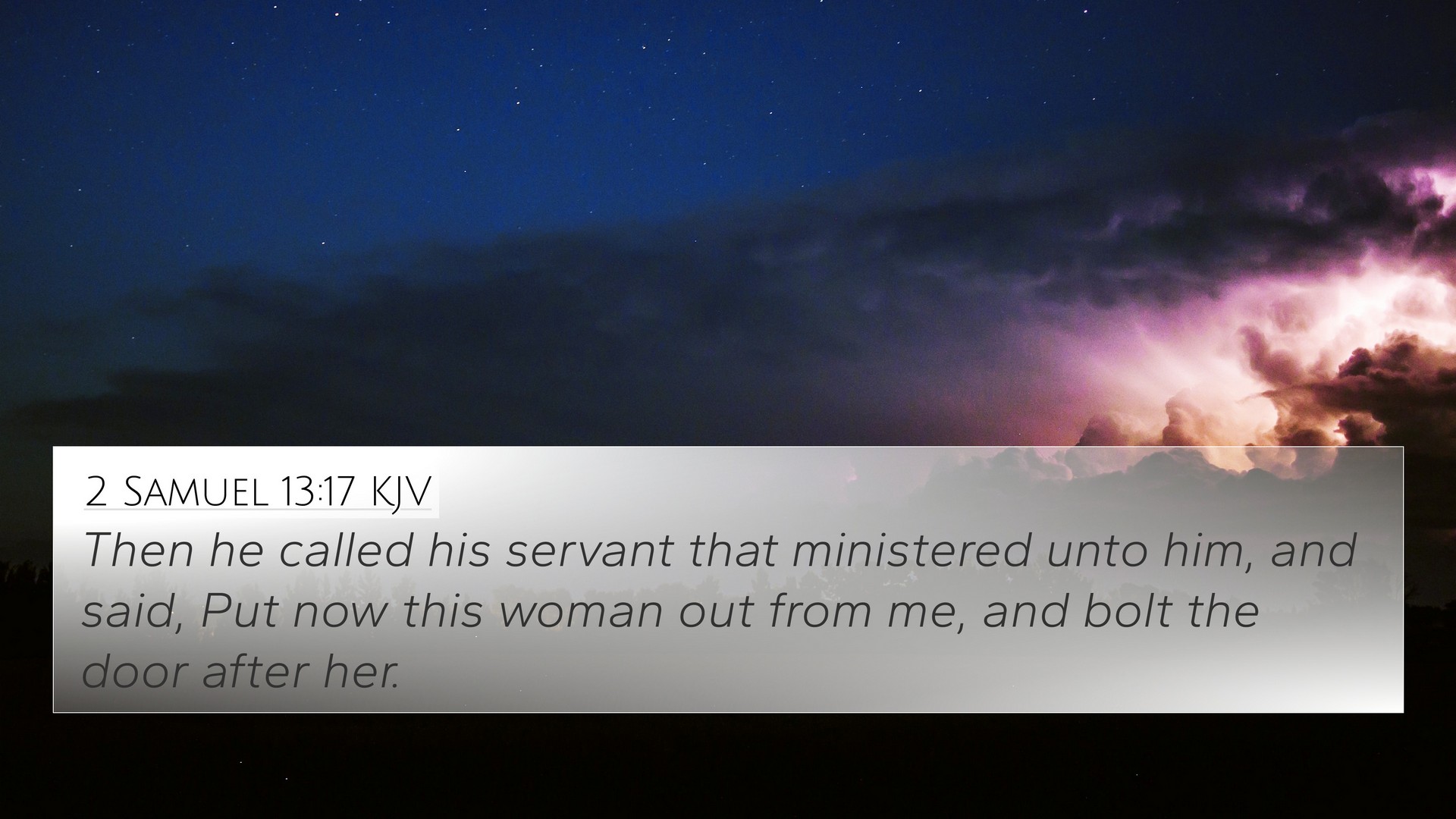Understanding 2 Samuel 13:17
Verse: 2 Samuel 13:17: "And he called his servant that ministered unto him, and said, Put now this woman out from me, and bolt the door after her."
Summary of the Verse's Meaning
This poignant moment in 2 Samuel reveals deep emotions and severe consequences stemming from the tragic events leading up to it. Amnon, the son of King David, is grappling with intense feelings after his illicit act with his half-sister Tamar. The request to have her removed reflects not only his shame but also the degrading of her dignity. The bolting of the door signifies a definitive rejection, further complicating Tamar's plight as a victim.
Insights from Public Domain Commentaries
-
Matthew Henry:
Henry emphasizes the ruthlessness of Amnon's actions. His desire to remove Tamar showcases the lack of responsibility felt by one who has wronged another. Henry points out that such acts lead to despair and honor is stripped from the innocent party.
-
Albert Barnes:
Barnes interprets the rejection of Tamar as a demonstration of Amnon’s internal conflict. His desire for her earlier turned to loathing afterward, highlighting the destructive nature of lust and how it leads to cruelty, casting light on the psychological turmoil faced by the wrongdoer.
-
Adam Clarke:
Clarke discusses the implications of castration of Tamar’s honor and dignity through this act. He focuses on the societal repercussions and emphasizes the importance of understanding the narrative within the context of familial relationships and moral failings.
Cross-References and Thematic Connections
This verse connects to several other Bible verses that illuminate the themes of sin, shame, and redemption:
- Genesis 34:2: The story of Dinah highlights the dangers of sexual immorality within family dynamics and its devastating effects.
- Proverbs 6:32-33: Warns of the consequences of adultery, emphasizing the destruction it brings to a man’s honor.
- 2 Samuel 13:14: Earlier in the chapter, Tamar pleads with Amnon, illustrating the violent conflict between familial loyalty and betrayal.
- Micah 6:16: Points to the consequences of the royal family's failure to act justly, linking to the broader theme of accountability.
- Galatians 6:7: “For whatever a man sows, that he will also reap,” a principle that resonates through the fallout of Amnon's actions.
- Matthew 5:28: Jesus’ teaching on lust illustrates the moral implications and heart issues related to Amnon's sin.
- 1 Corinthians 10:11: Reminds believers that the mistakes of others serve as lessons for spiritual lessons on moral failures and sin.
Thematic Bible Verse Connections
The themes of shame, guilt, and the consequences of sin resonate throughout the Scriptures. This passage serves as a stark reminder of the broader biblical narrative regarding morality, relationships, and the holistic understanding of personal failings in light of God’s law.
Related Bible Verses for Further Study
For a deeper understanding, consider exploring the following verses:
- Romans 6:23 – The wages of sin.
- Psalms 51:2 – David’s prayer of repentance reflects the weight of guilt.
- James 1:15 – The progression of sin and its consequences.
- Mark 7:21-23 – Jesus speaks about the source of evil actions.
Conclusion
In conclusion, 2 Samuel 13:17 serves as a profound warning against the destructive power of unchecked desires and the ramifications of moral failures within intimate family relationships. By engaging with cross-referencing biblical texts, readers can better appreciate the complexities of these narratives and the timeless truths they convey.


